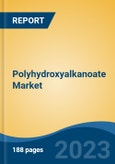Speak directly to the analyst to clarify any post sales queries you may have.
10% Free customizationThis report comes with 10% free customization, enabling you to add data that meets your specific business needs.
Key Market Drivers
Growing Demand of Polyhydroxyalkanoate in Packaging Industry
The demand for sustainable alternatives to conventional plastics is accelerating, especially in the packaging sector, which accounts for a substantial portion of global plastic use. Polyhydroxyalkanoate (PHA), a fully biodegradable bioplastic derived from the fermentation of sugars or lipids by bacteria, presents a viable solution. PHA’s ability to decompose naturally without leaving toxic residues makes it an attractive option for eco-conscious manufacturers and consumers alike. As environmental concerns mount, the packaging industry is increasingly turning to materials that offer both performance and sustainability.Plastic packaging remains economically significant, with the global market valued at over USD 413.89 billion in 2024. PHA’s lightweight, durable, and versatile nature allows it to replace petroleum-based plastics in a wide array of packaging applications. As regulatory pressures to curb plastic waste intensify, industries are integrating PHA to align with circular economy goals, reduce landfill contributions, and lower their carbon footprint. This shift is positioning PHA as a key material in the future of sustainable packaging.
Key Market Challenges
Lack in Availability of Feedstock
The production of Polyhydroxyalkanoate relies heavily on the availability and affordability of renewable feedstocks such as corn, sugarcane, and used cooking oil. These inputs are subject to fluctuating supply dynamics due to competing demands from food production and biofuel sectors, which limits the consistent availability of raw materials for PHA manufacturing. In regions where agricultural resources are scarce or diverted for other uses, feedstock shortages hinder production scalability and operational efficiency.Moreover, cultivating and processing these crops requires significant land and water resources, raising concerns about environmental sustainability and cost implications. These constraints contribute to higher production expenses, which in turn elevate the end cost of PHA products compared to traditional plastics. As a result, price-sensitive markets may be slow to adopt PHA, limiting its market penetration. Addressing these challenges will require improved agricultural efficiency, alternative feedstock sources, and technological advancements in fermentation and processing to enhance yield and cost competitiveness.
Key Market Trends
Rising Demand for Biodegradable Plastics
There is a growing global emphasis on biodegradable materials as a solution to plastic pollution, and PHA is emerging as a leading contender. Derived from renewable resources, PHA offers the advantage of natural decomposition, minimizing environmental harm and aligning with circular economy principles. As governments, corporations, and consumers pursue sustainable alternatives, the demand for bioplastics like PHA is rising across industries.PHA is increasingly used in diverse applications - from food service packaging to agricultural films and biomedical devices - thanks to its adaptability and eco-friendly lifecycle. Its biodegradable properties ensure minimal environmental residue, making it especially suitable for single-use products that traditionally contribute to plastic waste. This trend is further supported by policy measures aimed at reducing plastic consumption and promoting green alternatives, reinforcing the market shift toward materials like PHA.
Key Market Players
- Bio-on SpA
- CJ CheilJedang Corp.
- Danimer Scientific, Inc.
- Genecis Bioindustries Inc.
- Kaneka Corporation
- RWDC Industries Limited
- Tepha Inc.
- TerraVerdae Inc.
- Tianjin GreenBio Materials Co., Ltd.
- NEWLIGHT TECHNOLOGIES, INC.
Report Scope:
In this report, the Global Polyhydroxyalkanoate Market has been segmented into the following categories, in addition to the industry trends which have also been detailed below:Polyhydroxyalkanoate Market, By Type:
- Short Chain Length
- Medium Chain Length
- Others
Polyhydroxyalkanoate Market, By Application:
- Packaging & Food Services
- Biomedical
- Agriculture
- Others
Polyhydroxyalkanoate Market, By Region:
- North America
- United States
- Canada
- Mexico
- Europe
- France
- United Kingdom
- Italy
- Germany
- Spain
- Asia Pacific
- China
- India
- Japan
- Australia
- South Korea
- South America
- Brazil
- Argentina
- Colombia
- Middle East & Africa
- South Africa
- Saudi Arabia
- UAE
Competitive Landscape
Company Profiles: Detailed analysis of the major companies present in the Global Polyhydroxyalkanoate Market.Available Customizations:
With the given market data, the publisher offers customizations according to a company's specific needs. The following customization options are available for the report.Company Information
- Detailed analysis and profiling of additional market players (up to five).
This product will be delivered within 1-3 business days.
Table of Contents
Companies Mentioned
- Bio-on SpA
- CJ CheilJedang Corp.
- Danimer Scientific, Inc.
- Genecis Bioindustries Inc.
- Kaneka Corporation
- RWDC Industries Limited
- Tepha Inc.
- TerraVerdae Inc.
- Tianjin GreenBio Materials Co., Ltd.
- NEWLIGHT TECHNOLOGIES, INC.
Table Information
| Report Attribute | Details |
|---|---|
| No. of Pages | 185 |
| Published | July 2025 |
| Forecast Period | 2024 - 2030 |
| Estimated Market Value ( USD | $ 92.65 Million |
| Forecasted Market Value ( USD | $ 124.73 Million |
| Compound Annual Growth Rate | 5.2% |
| Regions Covered | Global |
| No. of Companies Mentioned | 10 |









